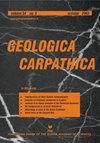Magnetic fabrics in the turbidite deposits of the Central Carpathian Paleogene Basin in relation to sedimentary and tectonic fabric elements
IF 1.5
4区 地球科学
Q4 GEOSCIENCES, MULTIDISCIPLINARY
引用次数: 2
Abstract
Anisotropy of magnetic susceptibility and anisotropy of anhysteretic remanent magnetization were studied in the Oligocene turbidites of the weakly deformed Central Carpathian Paleogene Basin. In order to decide whether the magnetic fabric can be related to deposition from a paleoflow or to incipient weak tectonic deformation we compared magnetic fabrics in individual intervals of the Bouma sequence with sedimentary structures and tectonic brittle mesostructures (joints). In the Ta–Te intervals we observed a good correlation between maximum susceptibility axes and SW(W)–NE(E) oriented paleoflows. Within convoluted and slump folded sandstones the AMS fabric coincides with the orientation of soft-sediment deformation structures. These features suggest the sedimentary origin of the AMS fabric. Three types of AARM sub-fabric were distinguished. The AARM type 1 represents magnetic foliations parallel either to NNW–SSE or to NE–SW oriented joints with magnetic lineations distributed along the joins. In the AARM type 2 magnetic foliations remained parallel to the bedding while magnetic lineations group around the joint to bedding intersections. The AARM type 3 coincides with the AMS fabric. Magnetic and microscopic analyses indicate that the AARM fabrics are connected to magnetite associated with subordinate ferrimagnetic iron sulphides. Both minerals occur in a sub-microscopic size and formed most likely during late diagenesis through the alteration of pyrite, possibly accompanied by burial clay transformation processes. The growth of the authigenic ferrimagnetic minerals was conditioned by combined effects of the sedimentary petrofabric, lithology and stress conditions during the inversion of the basin in the Early to Middle Miocene.中喀尔巴阡古近纪盆地浊积岩磁性组构与沉积构造组构元素的关系
研究了喀尔巴阡盆地中部弱变形古近系渐新世浊积岩磁化率的各向异性和非滞后剩余磁化强度的各向异性。为了确定磁组构是否与古流沉积有关,还是与早期的弱构造变形有关,我们将波马层序各层段的磁组构与沉积构造和构造脆性介构造(节理)进行了比较。在Ta-Te层段,最大磁化率轴与SW(W) -NE (E)向古流体具有良好的相关性。在卷曲和滑塌褶皱砂岩中,AMS组构与软沉积变形构造的取向一致。这些特征提示了AMS构造的沉积成因。区分了三种类型的AARM子织物。AARM 1型为平行于NNW-SSE或NE-SW方向节理的磁片理,沿节理分布。在AARM型中,2型磁性片理与层理保持平行,而磁性线理在节理与层理相交处周围聚集。AARM 3型与AMS织物相吻合。磁性和显微分析表明,AARM结构与次级铁磁性硫化铁伴生的磁铁矿相连。这两种矿物都以亚显微尺寸出现,很可能是在晚期成岩作用中通过黄铁矿的蚀变形成的,可能伴随着埋藏粘土的转化过程。早中新世至中中新世盆地反转期间沉积岩组构、岩性和应力条件的综合作用制约了自生铁磁性矿物的生长。
本文章由计算机程序翻译,如有差异,请以英文原文为准。
求助全文
约1分钟内获得全文
求助全文
来源期刊

Geologica Carpathica
地学-地球科学综合
CiteScore
2.40
自引率
23.10%
发文量
26
审稿时长
>12 weeks
期刊介绍:
GEOLOGICA CARPATHICA covers a wide spectrum of geological disciplines including geodynamics, tectonics and structural geology, volcanology, stratigraphy, geochronology and isotopic geology, karstology, geochemistry, mineralogy, petrology, lithology and sedimentology, paleogeography, paleoecology, paleobiology and paleontology, paleomagnetism, magnetostratigraphy and other branches of applied geophysics, economic and environmental geology, experimental and theoretical geoscientific studies. Geologica Carpathica , with its 60 year old tradition, presents high-quality research papers devoted to all aspects not only of the Alpine-Carpathian-Balkanian geoscience but also with adjacent regions originated from the Mediterranean Tethys and its continental foreland. Geologica Carpathica is an Official Journal of the Carpathian-Balkan Geological Association.
 求助内容:
求助内容: 应助结果提醒方式:
应助结果提醒方式:


